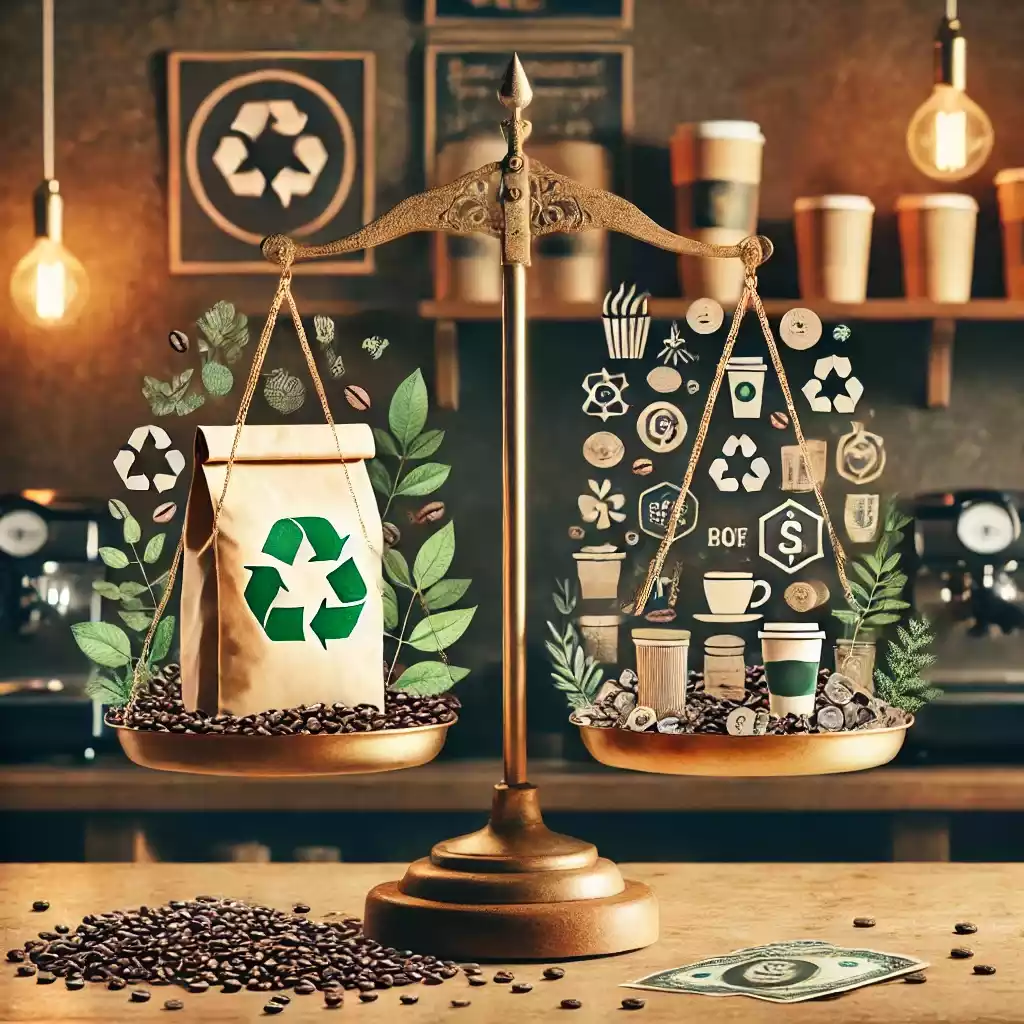Last updated on December 15th, 2024 at 06:58 pm
Learn how to balance cost and sustainability in coffee packaging with effective strategies. Discover cost-effective, eco-friendly packaging solutions for a greener coffee industry.
Introduction
Importance: In today’s coffee industry, finding the right balance between cost and sustainability in packaging is more crucial than ever.
Consumer Demand: As awareness of environmental issues grows, brands are under pressure to adopt eco-friendly practices without increasing costs significantly.
Focus: This balancing act involves making informed decisions about packaging materials, manufacturing processes, and overall environmental impact.
Objective: Understanding how to balance cost and sustainability is essential for companies aiming to meet both financial and environmental goals. This article will explore strategies to achieve this balance.

Understanding the Cost Factors in Coffee Packaging
When balancing cost and sustainability, it’s essential to understand the cost factors involved in packaging:
Raw Material Costs:
Traditional materials like plastic and aluminum are cheaper but have a higher environmental impact.
Eco-friendly alternatives (biodegradable plastics, recycled paper) may have higher upfront costs but offer long-term savings by reducing waste and supporting sustainability goals.
Manufacturing Expenses:
More sustainable materials often require different production techniques or equipment, which may increase expenses. For instance, biodegradable materials need specialized production processes.
Distribution and Logistics:
Packaging choices influence shipping and distribution costs.
Lightweight and compact packaging can reduce transportation costs and lower the carbon footprint, making it easier to manage overall packaging costs while striving for sustainability.
For a deeper dive into cost factors, check Packaging Strategies
Sustainable Packaging Options for Coffee
Exploring eco-friendly alternatives to traditional packaging is key to balancing sustainability and cost:
Eco-Friendly Materials:
The use of biodegradable and compostable materials like cornstarch-based bioplastics, or plant-coated paper, reduces waste without sacrificing quality.
These materials naturally break down, unlike conventional plastic, offering a long-term, sustainable solution.
Innovative Packaging Solutions:
Advances in packaging technology are offering more sustainable solutions without compromising freshness. For example:
Flexible packaging made from recycled materials.
Edible packaging options are being explored to eliminate waste completely.
For more details on the cost factors of coffee packaging, see Packaging Strategies.
Certifications and Standards:
Certifications like FSC (Forest Stewardship Council) and Cradle to Cradle ensure that packaging meets rigorous environmental standards.
These labels add credibility to eco-friendly claims and help both consumers and businesses identify sustainable options.
Visit Sustainable Packaging Coalition for more eco-friendly options._
Strategies to Balance Cost and Sustainability
Achieving the right balance between cost and sustainability requires careful planning and smart decision-making:
Lifecycle Cost Analysis:
Evaluating the total environmental and economic costs of packaging from production to disposal helps brands understand the full impact.
By comparing sustainable options with traditional ones, businesses can make decisions that align with both financial and environmental goals.
Cost-Benefit Analysis of Sustainable Materials:
Though sustainable materials might come with higher upfront costs, they can lead to long-term savings by reducing waste management fees and enhancing brand value.
Conducting a thorough cost-benefit analysis shows how eco-friendly packaging pays off over time.
Supplier Partnerships:
Collaborating with suppliers that prioritize sustainability can lead to more cost-effective packaging solutions.
Suppliers that specialize in eco-friendly materials often offer competitive pricing and insights into cost-saving opportunities.
For examples of cost-effective packaging, visit GreenBiz._
Case Studies of Successful Balancing
Examining successful examples can offer valuable insights for brands looking to balance cost and sustainability:
Stumptown Coffee Roasters:
Switched to recyclable materials and reduced their packaging footprint, aligning their packaging practices with environmental values while keeping costs manageable.
Blue Bottle Coffee:
Adopted compostable coffee bags made from renewable resources. Although there was a higher initial investment, they saw returns through enhanced brand loyalty and reduced waste management costs.
Key Takeaways:
Brands that make strategic investments in sustainable packaging often see improvements in environmental impact and customer satisfaction.
Collaborating with suppliers who share sustainability goals is essential for success.
For more case studies, check Packaging Digest._
Future Trends in Coffee Packaging
The coffee packaging industry is evolving, driven by new technologies and changing consumer preferences:
Emerging Technologies:
Biodegradable films, edible packaging, and smart packaging technologies are leading the charge for more sustainable packaging options.
These innovations reduce waste while maintaining packaging efficiency.
Consumer Expectations:
As consumers become more eco-conscious, their demand for sustainable packaging increases. Brands that invest in sustainable packaging solutions can gain a competitive advantage.
Regulatory Changes:. Brands that adopt sustainable practices will be better positioned to comply with future regulations and avoid penalties.
For more insights on future trends, visit Packaging Europe.
FAQ Section
What are the benefits of using eco-friendly coffee packaging?
Supports sustainable practices and meets consumer preferences for responsible products.
How can I balance cost and sustainability in coffee packaging?
Evaluate packaging options through lifecycle cost analysis and cost-benefit assessments.
What are some low-cost sustainable packaging options for coffee?
Recycled paper, biodegradable coffee bags, and lightweight materials reduce shipping costs. Innovations in green packaging can also offer cost-effective solutions.
How do certifications impact the sustainability of coffee packaging?
Certifications like FSC ensure packaging materials meet high environmental standards. They boost credibility and enhance consumer trust.
What trends are shaping the future of coffee packaging?
Advancements in biodegradable materials, increased demand for sustainability, and stricter regulations are driving future trends.
Conclusion
Balancing cost and sustainability in coffee packaging is a complex challenge that requires thoughtful analysis of materials, manufacturing processes, and long-term environmental impacts.
By conducting thorough lifecycle and cost-benefit analyses, adopting innovative packaging solutions, and keeping up with emerging trends, coffee brands can achieve a balance that meets both economic and environmental goals.
Embracing these strategies enhances brand reputation and supports the industry’s push toward a greener future.





